Introduction: Why Your Painted Furniture Might Be Failing You
Let’s be honest — painted furniture can be hit or miss. You’ve probably seen a few pieces that look more like a rushed craft project than a stylish design choice. Maybe the paint chipped after a few weeks, the color didn’t complement the space, or worse, the whole piece looked tacky instead of tasteful. It’s a common issue. Many people dive into painting furniture without understanding the prep work, choosing the wrong tools, or rushing through the process with low-quality materials.
The truth is, painted furniture ideas often fall flat not because the concept is flawed, but because the execution lacks intention. Choosing the wrong shade, skipping sanding, or ignoring finish protection can turn an otherwise beautiful piece into a regretful redo. But here’s the good news — you can absolutely avoid these pitfalls.
When done right, painted furniture ideas can completely transform your home. Whether you’re aiming for a cozy cottage look, a bold modern style, or something uniquely yours, a splash of the right color in the right place can breathe new life into tired, forgotten pieces. With just a bit of creativity and guidance, you’ll soon see how painted furniture can become the highlight of your decor — not the eyesore.
1. Choosing the Right Furniture to Paint
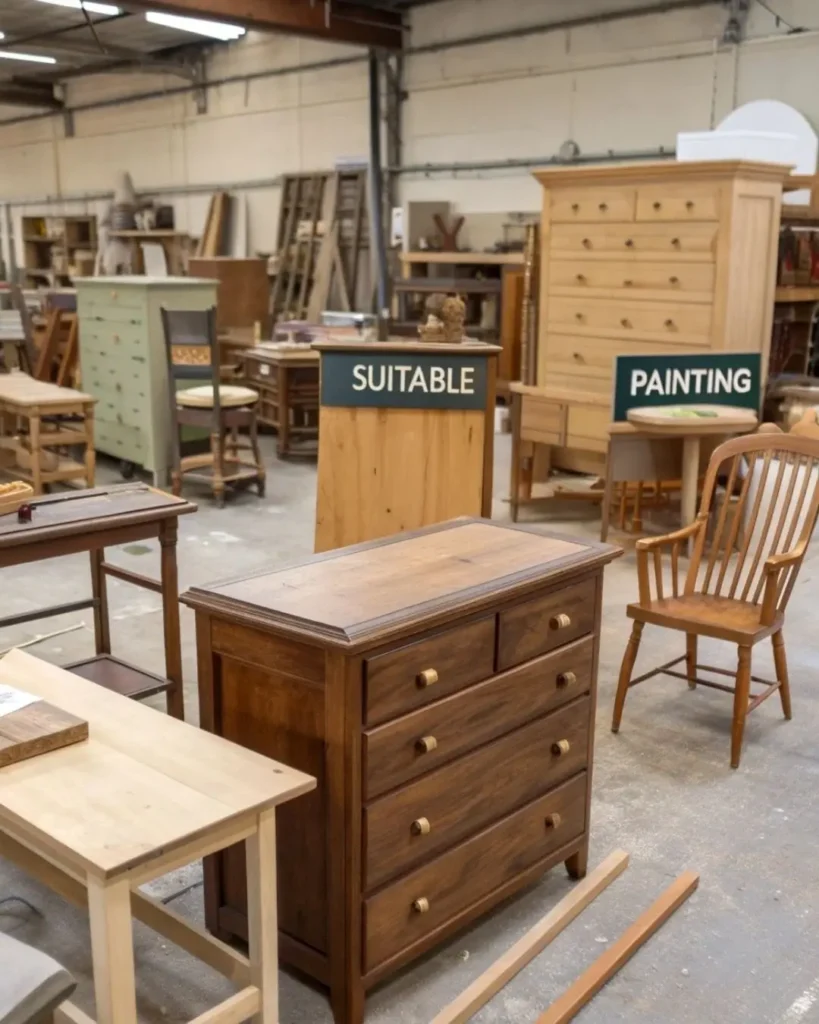
Before you dive into your next DIY project, let’s start with one of the most overlooked—but crucial—steps in any list of painted furniture ideas: choosing the right piece to paint. While it might be tempting to grab the first old chair or dresser you find in the attic or at a thrift store, not every piece is ideal for painting. In fact, painting the wrong furniture can lead to frustration, wasted materials, and underwhelming results.
Not Every Piece Is a Good Candidate
First, avoid painting valuable antiques unless you’re absolutely sure it won’t affect their value. Some vintage items are worth far more in their original condition. Similarly, furniture that’s heavily damaged—think deep cracks, rotting wood, or warped surfaces—often requires more repair than it’s worth. A fresh coat of paint can’t hide structural issues, and attempting to cover them up may only draw more attention to the flaws.
What to Paint: Best Furniture Types
The best pieces for painted furniture ideas are solid wood items with simple shapes and minimal detailing. Think dressers, side tables, bookshelves, and coffee tables. Wooden chairs, nightstands, and even cabinets also make excellent choices. These items are easy to sand, prime, and paint, which makes them perfect for both beginners and seasoned DIYers.
How to Assess Furniture Quality
Before starting, check the furniture’s stability. Give it a gentle shake—does it wobble? Are the joints loose? Look for water damage, peeling veneer, or extensive dents. Solid wood is ideal, but some MDF or laminate surfaces can also work if properly prepped. A quick test: lightly sand a hidden section—if it scuffs easily, it will likely hold paint well.
Choosing wisely is the foundation of all successful painted furniture ideas. Pick the right piece, and you’ve already won half the battle.
2. Common Mistakes When Painting Furniture (And How to Avoid Them)
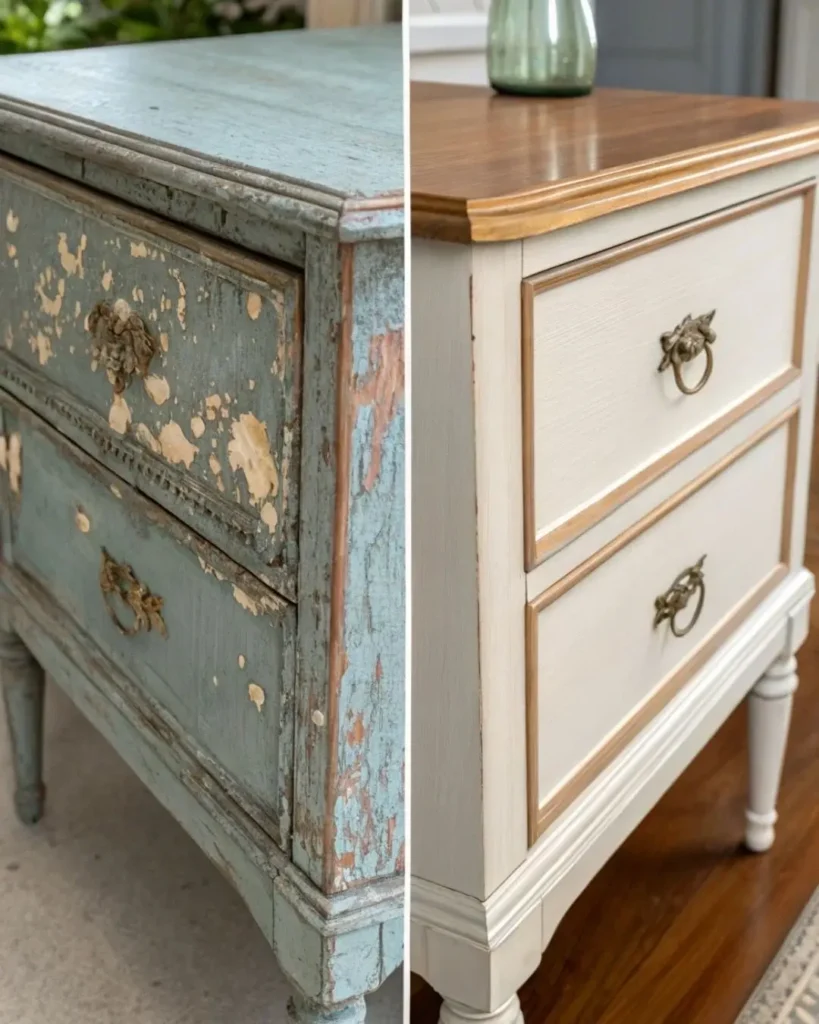
So, you’ve selected the perfect piece for your next makeover. Now comes the part where many DIYers slip up: the painting process itself. Even the most inspiring painted furniture ideas can fall apart without proper preparation and technique. Fortunately, most painting mistakes are completely avoidable — if you know what to look out for.
Mistake #1: Skipping the Prep Work
Preparation isn’t optional. Skipping sanding, cleaning, or priming can lead to uneven finishes, paint that peels, or stains that bleed through. Even if a piece looks clean, always give it a good wipe-down with a degreaser. Then, sand the surface to create grip for the paint. If the finish is glossy, scuff sanding is a must. Also, using a primer — especially on dark or stained wood — ensures the paint adheres better and lasts longer.
Mistake #2: Choosing the Wrong Paint Type
Not all paints are created equal. Latex paint may work well on certain pieces, but chalk paint or milk paint often gives a better matte finish and sticks more easily to furniture. Using leftover wall paint may seem convenient, but it typically lacks the durability needed for high-touch surfaces. When considering painted furniture ideas, always match your paint type to the surface and style you’re aiming for.
Mistake #3: Poor Technique and Tools
Using the wrong brush or applying too thick a coat can lead to brush strokes, bubbles, or drips. Opt for high-quality brushes or foam rollers, and always apply multiple thin layers instead of one thick one. Let each coat dry completely before adding the next.
Avoiding these simple mistakes can make a huge difference in your results. With the right approach, even basic painted furniture ideas can look like they came from a designer’s showroom.
3. Painted Furniture Ideas for the Living Room
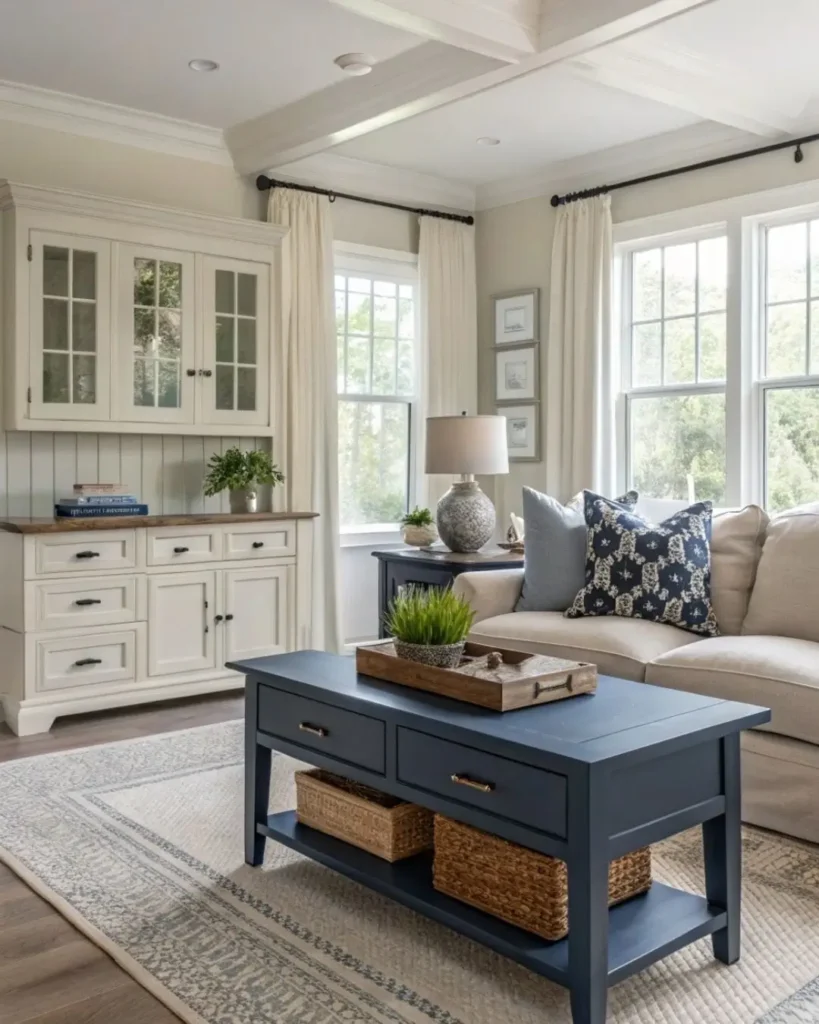
Your living room is the heart of your home—and one of the best places to experiment with painted furniture ideas for living room spaces that need a refresh. Whether your style leans toward cozy farmhouse, sleek minimalism, or bold and eclectic, a few well-painted pieces can completely redefine your interior.
Embrace the Warmth of Neutral Tones
If you love calm, clean spaces, neutral tones are your best friend. Shades like soft beige, warm white, and light gray create a soothing atmosphere and work beautifully with natural wood or linen textures. These hues are especially effective in farmhouse or minimalist living rooms, where subtle elegance takes center stage. A neutral painted coffee table or media console can instantly elevate your space without overwhelming it.
Add Energy with Bold Accent Pieces
On the other hand, don’t shy away from color. Bold painted accent pieces like a deep navy side table, an emerald green bookshelf, or even a mustard yellow armchair frame can bring life to an otherwise muted room. These colorful statements create visual interest and showcase your personality, making your space feel more curated and vibrant.
Try Two-Tone Designs or Dipped Legs
Looking for a creative twist? Two-tone furniture and dipped leg designs are playful yet stylish trends that work well in almost any room. For instance, a dresser with a white frame and natural wood drawers adds dimension, while a stool with color-blocked legs offers a modern, artistic flair. These painted furniture ideas for living room arrangements are especially great for adding a designer-inspired look on a DIY budget.
With just a little creativity and paint, your living room can feel brand new—without buying all-new furniture.
4. Painted Furniture Ideas for Bedrooms
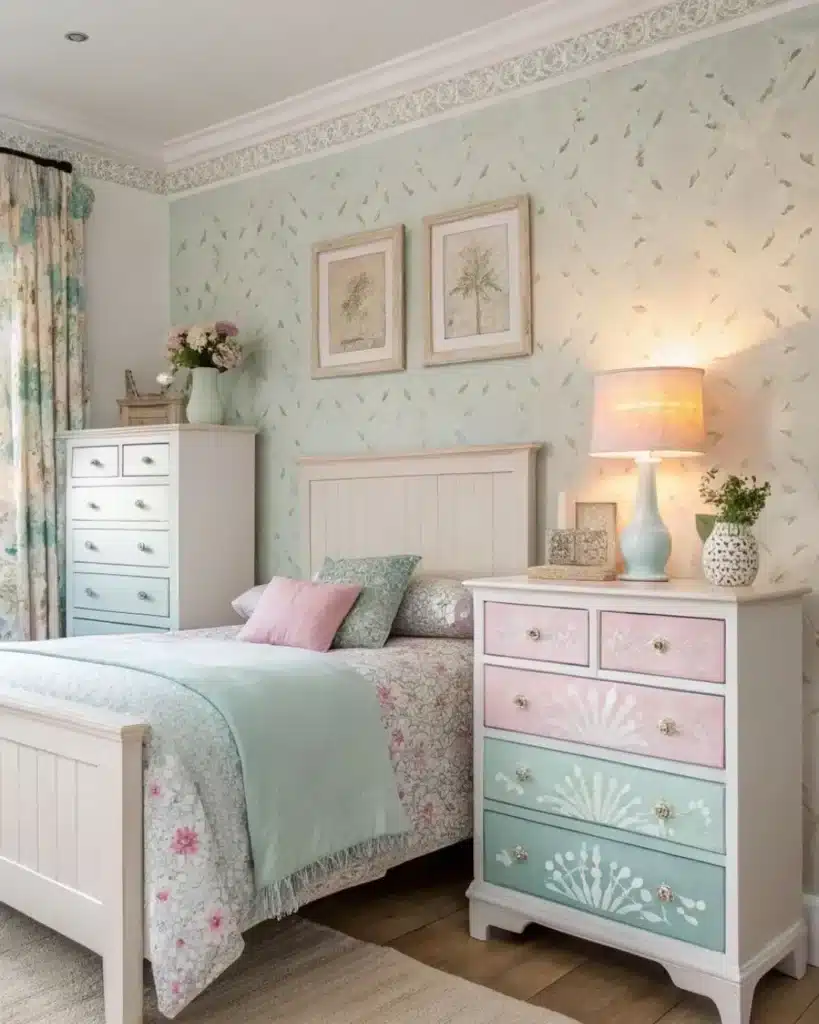
When it comes to creating a restful and personalized space, your bedroom deserves just as much design attention as any other room in your home. Fortunately, with the right approach, bedroom painted furniture ideas can help you achieve a stylish, tranquil atmosphere without overspending. From vintage touches to creative finishes, there are endless ways to upgrade your bedroom furniture using paint alone.
Revive Nightstands with Chalk Paint
Vintage nightstands are a perfect canvas for creativity. Chalk paint, known for its matte texture and ease of use, can give old wooden nightstands a charming, shabby-chic appearance. Whether you opt for soft pastels or earthy neutrals, this DIY painted furniture idea is beginner-friendly and requires minimal prep. If you’re looking for inspiration on how to style different nightstands to suit various bedroom aesthetics, check out our DIY nightstand ideas for every bedroom style. Add some vintage-style knobs, and you’ve got a designer look for a fraction of the cost.
Create a Statement with Ombre Dressers
If you’re looking to make a subtle yet impactful change, consider an ombre dresser. This gradient painting technique moves from light to dark (or vice versa) across the drawers and adds instant visual interest. It’s a creative take on traditional bedroom painted furniture ideas that works especially well in modern or boho interiors. Plus, it’s a great way to experiment with color without overwhelming the space.
Add Character with a Painted Headboard
Why settle for a plain headboard when you can turn it into a focal point? Stenciled patterns—like geometric shapes, florals, or even mandalas—can be painted directly onto a wooden headboard to bring depth and personality to your bedroom. Choose colors that tie into your bedding and wall decor for a cohesive, curated look.
With these DIY painted furniture tips, your bedroom can reflect your style beautifully—without the need for expensive updates.
5. Painted Furniture Ideas for the Kitchen & Dining Area

Your kitchen and dining area are more than just places to cook and eat—they’re spaces where family and friends gather, making them ideal for design updates that bring warmth and personality. With a little creativity and paint, you can easily turn dated furniture into beautiful, functional décor. These painted furniture ideas for kitchen transformations are simple, affordable, and guaranteed to make a big visual impact.
Refresh Bar Stools and Dining Chairs with Color
One of the easiest ways to refresh your kitchen is by painting your bar stools or dining chairs. Choose bright, cheerful colors like teal, mustard, or navy to add a splash of personality, or stick with whites and grays for a more timeless look. This small change can instantly energize your dining space without a full renovation. For an added touch, consider painting just the legs or the seat for a two-tone effect.
Embrace the Charm of Distressed Buffet Tables
A distressed buffet table is a cornerstone of rustic painted furniture style. Using techniques like dry brushing or sanding over chalk paint can give your furniture a gently weathered look that feels both cozy and authentic. These pieces work beautifully in farmhouse or vintage-inspired kitchens, adding both storage and visual appeal.
Update Cabinets with a Farmhouse Feel
Tired of plain or outdated cabinets? Try painting them in soft neutrals like cream, sage, or dove gray. Finish with matte hardware to create a clean, farmhouse-inspired vibe. These painted furniture ideas for kitchen spaces not only improve aesthetics but also add perceived value to your home.
By reimagining everyday kitchen furniture with paint, you can easily achieve a high-end look on a real-life budget.
6. Outdoor & Garden Painted Furniture Ideas
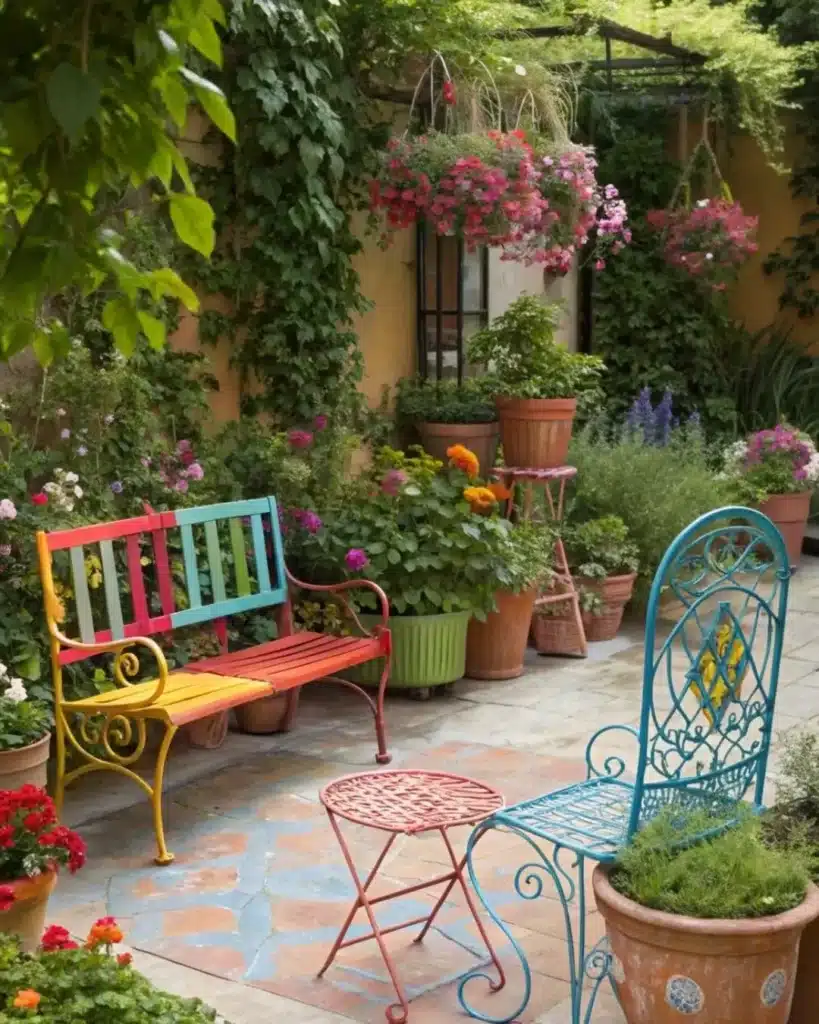
Don’t let your outdoor space be an afterthought. With just a few paintbrushes and the right products, your garden, patio, or balcony can become a vibrant extension of your home. These painted garden furniture ideas not only bring color and character to your outdoor areas but also help extend the life of your existing furniture.
Use Weatherproof Paints for Benches and Metal Pieces
Outdoor furniture is exposed to the elements year-round, so choosing the right paint is essential. Look for weatherproof or exterior-grade paint specifically designed to resist moisture, rust, and temperature changes. Whether you’re updating a wooden bench or a wrought-iron bistro set, preparation is key—sand away rust or peeling paint, clean the surface thoroughly, and apply a suitable primer if needed.
Pro Tip: For longer-lasting results, use UV-protected outdoor paint. It prevents fading caused by sun exposure and helps your vibrant colors stay true for seasons to come.
Brighten Up with Painted Terracotta Pots and Plant Stands
Looking for quick wins? Terracotta pots and metal plant stands are perfect DIY canvases. Use acrylic or spray paints in bold hues like turquoise, coral, or lemon yellow to inject playful energy into your garden. You can also stencil on patterns or use painter’s tape for clean, modern lines.
Follow Current Garden Table and Chair Color Trends
In 2025, yes trending outdoor painted furniture colors include earthy greens, classic whites, and warm terracottas. Mix and match these tones for a laid-back, Mediterranean-inspired look, or go bold with monochromatic themes for a more contemporary feel.
With these painted garden furniture ideas, your outdoor space can be just as stylish and personalized as your interior.
7. Furniture Painting Techniques & Finishes
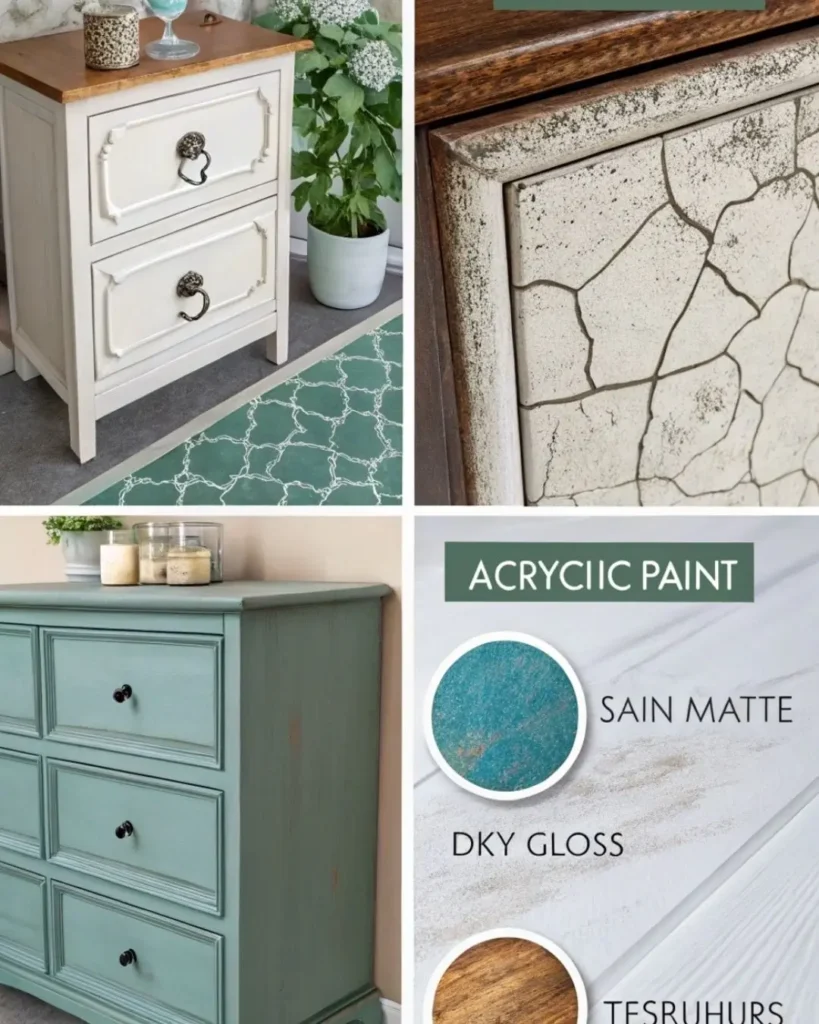
Once you’ve chosen the right piece and the perfect color, it’s time to focus on how you’ll apply that paint. Mastering a few essential furniture painting techniques can make the difference between a basic makeover and a magazine-worthy transformation. From the type of paint to the finish you select, every decision shapes your final look. The best part? You don’t have to be a professional to get professional-looking results.
Paint Types: Chalk, Milk, or Acrylic?
Chalk paint is beloved for its ultra-matte finish and ease of use—it requires little to no prep and offers a soft, vintage aesthetic. It’s ideal for shabby chic or rustic painted furniture styles.
Milk paint, while slightly less common, gives a beautifully aged, authentic look. It’s often used on raw wood and creates a naturally distressed texture that suits antique-style furniture.
Acrylic paint, on the other hand, is versatile and durable, making it perfect for more modern or high-use pieces. With proper sealing, acrylic can deliver long-lasting results in vibrant colors.
Spray Paint vs. Brush: Which Should You Use?
Spray paint is great for small, intricate items like metal chairs or wicker furniture. It provides a smooth, even coat and dries quickly. Brushes, however, give you more control on larger or flat surfaces, especially when working with specialty paints like chalk or milk.
For best results, use a high-quality synthetic brush to minimize strokes or a foam roller for ultra-smooth finishes.
Finish Options: Matte, Satin, or Gloss?
Your choice of finish depends on the look you’re after. Matte finishes lend a soft, understated feel. Satin offers a bit more sheen and is easier to clean—perfect for high-traffic pieces. Gloss delivers shine and boldness but can highlight imperfections.
Specialty Techniques: Crackle, Dry Brushing, and Stenciling
For added texture and creativity, try crackle finishes (great for antique effects), dry brushing for a weathered look, or stenciling to add intricate designs. These techniques help bring character and depth to even the simplest painted furniture styles.
By experimenting with different furniture painting techniques, you can create one-of-a-kind pieces that truly reflect your personal style.
8. How to Choose the Perfect Color

Selecting the right color can make or break your furniture makeover. While there are countless painted furniture ideas to explore, choosing a color that complements your space is essential for a polished, cohesive look.
Match Your Room’s Color Palette
Start by observing the dominant tones in your room—walls, floors, rugs, and decor. If your space features cool neutrals like gray or white, soft blues or sage green can create a soothing flow. For warmer interiors with wood or beige tones, consider terracotta, olive, or mustard for a cozy effect. Your furniture should either blend beautifully or stand out with intention.
Trending Colors for 2025
This year, designers are leaning into rich, earthy tones and nature-inspired shades. Expect to see deep forest greens, muted rusts, clay reds, and warm ochres as go-to choices. These hues add warmth and sophistication, making them some of the best colors for painted furniture in 2025.
Use a Color Wheel for Smart Contrast
If you’re unsure about what works, a color wheel can guide you. Complementary colors (opposites on the wheel) create bold, lively contrast—like navy blue against coral—while analogous colors (next to each other) offer a more harmonious, blended feel.
Expert Insight: How Designers Choose
Interior designers often test swatches in natural light before committing. They also consider how the color interacts with existing textures, lighting, and the room’s purpose. For example, relaxing colors work best in bedrooms, while vibrant hues are great for accent pieces in living areas.
Ultimately, when it comes to painted furniture ideas, the right color can elevate a simple project into a statement piece.
9. Eco-Friendly and Safe Painting Tips

As awareness around health and environmental impact grows, many DIYers are seeking eco-friendly painted furniture options that are both safe for their families and kind to the planet. Thankfully, creating beautiful, sustainable furniture doesn’t mean sacrificing quality or style. With a few mindful choices, you can enjoy stunning results while minimizing your ecological footprint.
Choose Low-VOC or Zero-VOC Paints
Traditional paints often contain volatile organic compounds (VOCs), which can release harmful fumes into your home. When working indoors—or around children and pets—it’s best to opt for non-toxic furniture paint. These low-VOC or VOC-free options are now widely available in both chalk, milk, and acrylic formulas, offering safer alternatives without compromising color or durability.
Use Natural Paints and Sealants
If you want to go fully green, consider natural milk paint or mineral-based formulas. These contain fewer synthetic chemicals and often come in powder form, which you mix with water before application. For sealing, beeswax and plant-based oils are excellent substitutes for petroleum-based finishes.
Practice Safe Disposal
Another often-overlooked aspect of eco-conscious painting is proper waste management. Never pour leftover paint down the drain. Instead, seal it tightly and take it to a hazardous waste facility or reuse it for smaller projects.
Upcycle and Reduce Waste
Finally, embracing eco-friendly painted furniture also means reducing waste by reusing and repurposing what you already own. An old dresser can become a bathroom vanity, or a forgotten chair can take on new life with a creative paint job.
By choosing non-toxic furniture paint and following these eco-minded practices, you can transform your home responsibly—one brushstroke at a time.
10. Budget-Friendly DIY Painted Furniture Projects

Transforming your home doesn’t have to drain your wallet. In fact, some of the most impressive DIY painted furniture ideas come from pieces found at yard sales, flea markets, or even the curb. With a little vision and a few supplies, you can turn overlooked items into stunning focal points that feel custom and high-end.
Thrift Store Treasures
Local thrift shops are goldmines for budget-friendly pieces. Look for items made of solid wood or sturdy construction—even if they’re a little worn. A basic end table or outdated dresser can become a statement piece with just a coat or two of paint. Stick to classic shapes, as these tend to age well and blend with various décor styles.
Curbside Rescues
Yes, free furniture can be fabulous! Many people discard perfectly usable items simply because they look outdated. If you’re up for a little elbow grease, these finds can be prime candidates for your next budget furniture makeover. Just make sure to inspect for pests or water damage before bringing them inside.
Repurpose What You Already Have
Sometimes the best DIY project starts right in your own home. Consider repainting old shelves, stools, or side tables that no longer match your style. Changing the color, swapping hardware, or adding stenciled designs can give tired furniture a second life—without spending a cent.
Save on Supplies
Don’t forget, leftover paint from previous projects can be reused creatively. Mix colors to create custom shades, or use painter’s tape to design bold geometric patterns. With smart planning and a touch of creativity, DIY painted furniture ideas can easily become your favorite way to decorate on a dime.
Excellent! Here’s the optional comparison table of furniture paint types, designed to be clear, helpful, and visually engaging. It supports readers in choosing the best paint for their project, which enhances both SEO and user experience.
Furniture Paint Type Comparison Table
| Paint Type | Finish Options | Best For | Pros | Cons |
| Chalk Paint | Matte | Vintage, shabby chic looks | Minimal prep, easy to distress, soft matte texture | Requires sealing (wax or polyurethane) |
| Milk Paint | Matte, aged texture | Raw wood, rustic or antique styles | Natural ingredients, eco-friendly, lovely patina | Can be unpredictable on slick surfaces |
| Acrylic Paint | Satin, Gloss | Most surfaces (wood, laminate) | Durable, vibrant colors, widely available | Needs primer and sealer for best results |
| Latex Paint | Satin, Semi-gloss, Gloss | Modern pieces, cabinets | Easy to clean, affordable, low odor | Can chip without proper sanding and priming |
| Spray Paint | Various (depends on type) | Metal, plastic, wicker | Smooth finish, quick drying, great for hard-to-brush items | Requires ventilation, can be messy without care |
This table can serve as a quick reference for readers navigating the world of painted furniture ideas, helping them make informed decisions based on finish, durability, and style.
Conclusion: Your Next Painted Furniture Makeover Starts Now
As you’ve seen throughout this guide, the world of painted furniture ideas is both inspiring and accessible. From choosing the right piece and prepping it correctly, to experimenting with bold colors, unique finishes, and creative DIY techniques—there are endless ways to breathe new life into old furniture.
By avoiding common mistakes, selecting the right paint, and exploring styles that fit your personality and home décor, you can confidently transform even the most tired item into something fresh and beautiful. Whether you’re painting a thrifted dresser, giving your garden bench a makeover, or adding charm to a bedroom nightstand, each project becomes a reflection of your taste and creativity.
And the best part? You don’t need a huge budget or professional tools to get started. Many of these painted furniture ideas can be done in a single weekend with items you already have at home.
So here’s your next step: pick one small project, gather your materials, and start painting! Don’t be afraid to experiment—you’ll gain experience with every brushstroke. And if you ever feel stuck, there are always helpful communities, tutorials, and pros ready to guide you. For additional inspiration and expert guidance, you can explore trusted resources like Martha Stewart’s DIY archive or browse project ideas on The Spruce to expand your creativity even further.
Let your furniture be the canvas. It’s time to create something truly unique.
FAQs: Painted Furniture Ideas
What are the best colors to paint furniture?
The best colors to paint furniture depend on your design goals and the room’s existing palette. For a timeless look, neutral tones like white, gray, and beige remain popular. Earthy greens, soft blues, and muted terracotta shades are trending in 2025 and work well in both modern and rustic settings. If you’re using bold painted furniture ideas, jewel tones like emerald, navy, or deep plum can make a dramatic statement. Always test a swatch in your space before committing.
Can I just paint furniture without sanding?
Technically, yes—but it’s not always recommended. Some modern painted furniture ideas use no-sand techniques, especially when applying chalk or mineral paint, which adhere better to surfaces without heavy prep. However, sanding helps create a smoother surface and improves paint adhesion, especially for glossy or previously finished pieces. Light sanding is often enough and ensures your paint lasts longer and looks more professional.
What is the best paint for furniture?
The best paint for furniture depends on the material and the finish you want. Chalk paint is great for a matte, vintage style and requires minimal prep. Milk paint offers a natural, distressed finish, perfect for rustic looks. Acrylic and latex paints are durable and ideal for modern or high-use furniture. No matter which you choose, sealing the piece properly is key to longevity—especially for high-traffic items.
Should you put a clear coat over painted furniture?
Yes, in most cases. A clear coat adds durability, prevents chipping, and protects your paint job from wear and tear. Especially with chalk or milk paints, applying a wax or polyurethane finish can significantly extend the life of your piece. For outdoor or high-moisture areas, use a water-resistant sealant. Protecting your painted furniture ideas with the right topcoat ensures they stay beautiful for years.


